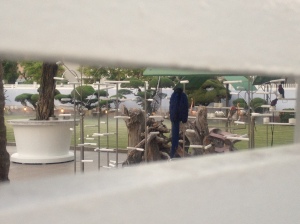We’re sitting in a corner room in the empty ground-floor apartment we’ve borrowed from a friend; out of both windows, palms, villas, bougainvillea. It’s strange being in the wealthy East Coast and in this enclosed and privatised urban environment after the communality of HDB life. I went for a stroll the first evening, down avenues of luxury attended with flowering trees of astounding exuberance. One old mansion on a corner plot is surrounded by a vast lawn, lined with great, distorted bonsais which are watered via a fine mist system; across the grass stalk flamingos and parrots of every hue shriek into suburbia. Later we walked down to the beach, where the wind was high and the seas rough; all along the coast hordes of holiday crowds moved through the darkness, and as we walked along Fei told me about what Descartes was all about.
Yesterday was searingly hot, everyone in Singapore mopping their brows and wilting under the ferocious solar waves; I went into the studio and worked really hard against the hammering heat and a head cold.
My unformed thoughts, or rather questions about different kinds of working – well, they really are unformed, but here goes, here they are. They are to do with subject matter, what we look at, and what we paint. If I’m making work about the immediate, external world around me, and am responding directly to the visual stimuli that world gives me, then does that direct relationship change not only how I make work – and what the making process feels like – but also, how I am in the world?
In a sense I think I am really talking about delight. Think of the delight, trudging through a vast collection, the National Gallery say, or the Louvre, past acres of Rubens and you come across a Chardin still life, or a clump of pine trees by Cezanne, or the corner of some Italian Renaissance painting, where your eyes fall with sheer relief on the blue-tinted landscape behind a Madonna’s shoulder, or the flat North European vistas in a Ruisdael, where you are taken into a specific, long-lost, blustery and lonely autumnal day in 17th Century Holland.
All these images use art, or artifice of course – Cezanne his waxed fruits and abstraction, Ruisdael his solitary disposition affecting his view of man in nature, the Italian painter’s vision perhaps tinted by dreams of cooler mountain air. I’m not talking either solely about directly observed work – Constable restructured and re-ordered his cloud studies back in his studio. But they all take you to a place, with a delight – what is this delight? It’s the delight of recognition, and also it’s the transport of delight back into memory, our mind’s storeroom of events and sensations and images.
So, my question is a simple, naive one; if you are in a state of delight with the natural world – by delight, I mean more specifically an interested engagement, or an intentional looking, and if your work is then an activity of making visible that delight, then does that make you more in the world? Is the process a circular one? If I were to paint the tree outside the window here, in which a bird is singing noisily right now, I would feel differently about the tree, see it differently, for evermore. I would feel more directly connected with it. Painting Singapore earlier this year made me more here, more in the experience.
Working from photos of elsewhere – of unvisited places, or images seen on screens – I am turning my back on the world outside the studio window. Dealing with these different sources I can explore and describe emotions beyond pure visual delight, such as love, or loss, distance, fear, or ideas stemming from concepts or theory or history, and there is a delight in all of this too.
But what I am missing, working in this second way, is pure, visual pleasure. There is something that gets under my skin about this urban landscape, and it keeps tugging at my sleeve and won’t let me go. It’s an almost physical sensation, like an inner rhythm or Gestalt – the dark square of an apartment window broken by the arc of a palm, shadows on cement. And above all, light, simultaneously radiant and melancholy, light of tristes tropiques.





I so know what you mean about finding a Chardin still-life in amongst all that oppulent Reubens flesh! How wonderful though Gavin that the urban landscape has got under your skin – I am sure that’s what’s required to make meaningful art. Love Jiffy